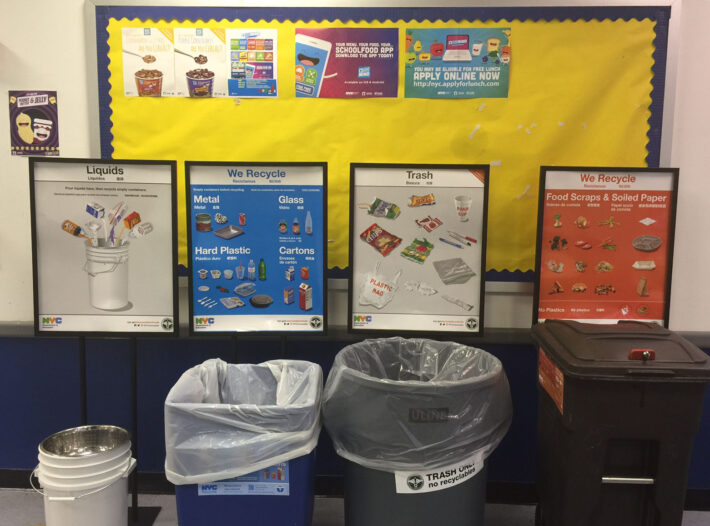
For 10-year-old kids, waste is not a priority issue — except at The Museum Magnet School in Midtown, where Natalie Gonzalez, a fifth grader, is proud to be recycling in class.
“I like that it helps everybody being mindful about where they put their waste,” she says.
Her school is one of two in the area participating in the Zero Waste Schools program, part of Mayor Bill de Blasio’s 2015 commitment to reach a zero waste goal by 2030. The Department of Education (DOE) partnered with the Department of Sanitation (DSNY) and GrowNYC to tailor an initiative to the schools, starting with 100 schools across the city. In five years, it hopes to establish model facilities before expanding to the over 1800 schools in New York City.
Participating schools like The Museum Magnet School (Pre-K to 8th grade) and West End Secondary School (6th and 7th grade) will try to reduce the amount of waste they send to landfills by sorting out organics and recycling metal, glass, paper, plastic and cardboard. It requires a behavioral shift from students and staff who are not all used to sorting their waste at home.
“We had it last year but people were not really following the rules. This year, more are getting involved”, says the fifth-grader.
DSNY launched its Organics Collection Program in 90 public schools in the 2012-2013 school year, and has expanded to collect over 7,000 tons of organic food scraps at over 730 schools, or 40 percent of the city’s public schools. The 100 schools in the Zero Waste program are located on two truck routes of the existing Organics Collection Program in Manhattan and Brooklyn.
Meredith McDermott, the DOE’s director of sustainability, tries to set a reasonable goal. “One hundred percent diversion rate is not accurate,” she says. “We think a reasonable number is a diversion rate of 85 percent”. Even though the program encourages reusing and reducing materials, like textbooks, there will always be leftovers that cannot be recycled, such as chips bags or packaging wraps.
City funds are distributed among the DOE, the DSNY and GrowNYC to cover the estimated $4.8 million cost of the program.
The novelty of the program is its focus on educational training and materials. For this part, the DOE called on GrowNYC, which already provides recycling training for 100 schools across the city.
Lesley Barewin is GrowNYC’s outreach coordinator for West End Secondary School and The Museum Magnet School. Her role is to facilitate the understanding of the program in the schools, as some of them were reluctant to participate at first. Before school started this fall, she held faculty workshops, and for the next three months she will be handling student outreach.
Barewin says that The Museum Magnet School chose to hold assemblies, one for each grade, where she would make a presentation and play games with the students. West End Secondary School (WESS), an Outward Bound school only in its second year, has another approach. Its “expeditionary learning” curriculum incorporates the Zero Waste Schools program directly into the science and math classes. Sixth graders will learn about zero waste and make a plan about the school’s waste production before presenting it to seventh graders.
“Students have an authentic audience to share their learning with,” says Emily Holliday, the science teacher at WESS. “It is exciting for them, purposeful.”
Holliday volunteered last year to be WESS sustainability coordinator, a mandatory position in every NYC school, and is the link between the DOE and the school. She oversees all sustainable activities in WESS, like the formation of a Green Team, a group of students who raise awareness of environmental issues among their classmates. For her, DOE support is a relief.
“It’s also new for parents to have an official DOE program for reducing waste,” Holliday adds. “During a ‘meet the teacher’ session, one of them asked me, ‘Is this real? Or did you create this scenario for the sake of kids’ learning?’ It is refreshing to see that it’s really happening. It’s real for the kids.”
But not everyone is on board. “Sometimes I look at the garbage bins in the cafeteria,” says Amaya Cassie, a third grader at The Museum Magnet School who is used to recycling glass, metal, paper and cardboard in her family. “And you can see that people don’t put the right things in it. They do it on purpose.”